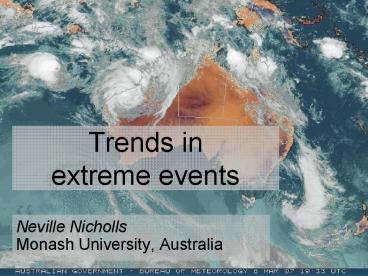Trends in extreme events PowerPoint PPT Presentation
1 / 18
Title: Trends in extreme events
1
Trends inextreme events
- Neville Nicholls
- Monash University, Australia
2
- IPCC Second Assessment of Climate Change, 1995
- Overall, there is no evidence, in a global sense,
that extreme weather events, or climate
variability, has increased through the 20th
century, although data and analyses are poor and
not comprehensive. - IPCC Third Assessment , 2001
- Increased frequency of heavy precipitation
events. - Decreased frequency of extreme low temperatures
increased frequency of extreme high temperatures. - Increased drought frequency intensity (some
regions). - No significant global trends in tropical
extratropical storm intensity and frequency - No systematic changes evident in frequency of
small-scale events such as tornadoes.
3
IPCC Fourth Assessment (2007)
4
USA Climate Change Science Program (Kunkel et
al., 2008)
- there has beenan increase in extreme high
temperatures and a reduction in extreme low
temperatures - heavy downpours have become more frequent and
more intense in recent decades over most of North
America and now account for a larger percentage
of total precipitation - averaged over the continental U.S.A. and southern
Canadathere is no indication of an overall trend
drought - Atlantic tropical storm and hurricane destructive
potential has increased - northward shift in the tracks of strong
low-pressure systems (storms) in both the North
Atlantic and North Pacific over the past fifty
years
5
Outstanding questions
- Hot and cold days/nights
- Relationship to changes in mean temperatures are
extremes changing faster than average
temperatures? - Heavy rainfall events
- Are these increasing even where total rainfall is
declining? - Drought
- What is the influence of warming circulation
changes? - Tropical cyclones
- Spatial variations in trends - links to ocean
temperature - Extra tropical storms
- Spatial variations in trends - links to general
circulation - El Niño - Southern Oscillation
- Has there been a trend to more or stronger Niño
events?
6
Australia laboratory for trends in extremes -
Spans tropics to mid-latitudes - Flat (few
mountains) - Long meteorological records
quality control - Single country (one data
archive)
Meteorology is perhaps a simpler problem in this
land than anywhere else. (Jevons, 1859)
Spencers Creek
Cape Otway
7
Melbourne, 1979-2001
27-30 January 2009 42.3C
8
Wildfires, late February 2009
9
Cool days
Cold nights
Warm nights
Hot days
Alexander et al., 2007. Colour indicates
significant trend in mean temperature 1957-2005
data.
10
Coldest night is warming faster than mean minimum
11
Number of very heavy rain days decreased in areas
where total rainfall decreased
1950-2008
12
Alexander et al 2007, Trends in Australias
climate means and extremes a global context
- trends in extremes of both temperature and
precipitation are very highly correlated with
mean trends. - most stations have greater absolute trends in
extremes than means. - some evidence that the trends of the most
extreme eventsare changing more rapidly than are
trends for more moderate extreme events. - consistent with all other global regions studied.
13
Droughts are getting hotter, even where they are
not getting drier
After Nicholls (2003, 2004)
14
Spring snow melt is earlier - leading to
streamflow changes
After Nicholls (2005)
15
Trends in tropical cyclone activity are not
simply related to SST trends
After Nicholls (1985) and Nicholls et al (1998)
16
Numbers of extra-tropical storms declining in
some areas
Alexander and Power (2009) storms diagnosed from
very large sub-daily pressure changes
17
It is too simplistic to say that there is a trend
towards more extreme climate weather
- More warm days/nights fewer cool days/nights
- Temperature extremes changing rapidly
- Trend in heavy precipitation frequency matches
trend in total precipitation - Droughts becoming warmer (if not drier)
- Drought changes linked to circulation trends
- No universal increase in tropical cyclones (or
link to warming ocean temperatures) - Latitudinal shift in mid-latitude synoptic
systems - No obvious trend towards stronger/more El Niño
events
18
Summary what important extremes have changed
globally?
- More heat waves fewer cold events
- More extreme sea level events
- Still dont know whether small-scale extremes
(hail, tornadoes) are changing - Changes in other extremes are regionally
dependent - But they are changing - less predictable

